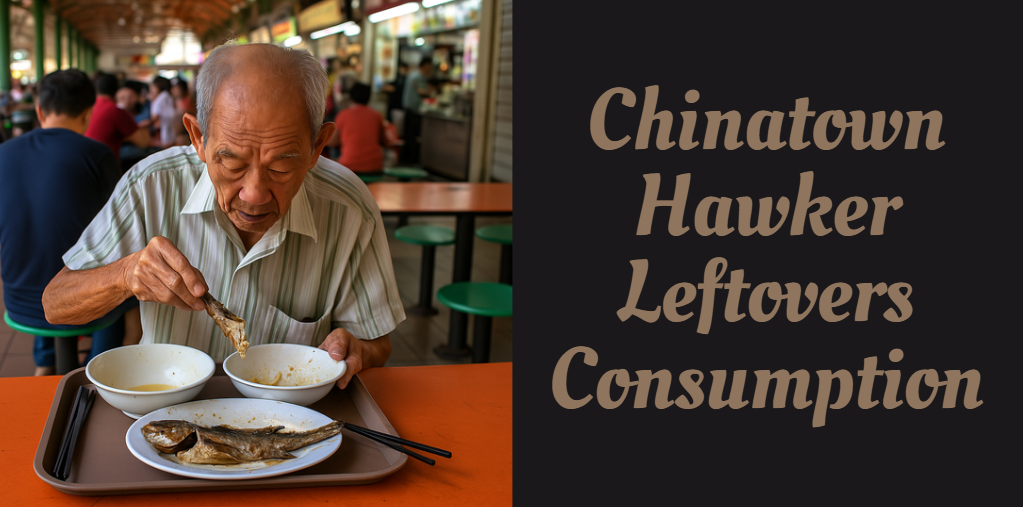The vibrant environment of Chinatown hawker centres is more than just a culinary hotspot—it’s a hub of tradition, innovation, and community interaction. Amidst the bustling activity, the practice of consuming leftover food has emerged as both a practical solution to food waste and a symbol of resourcefulness.
In this article, we explore how chinatown hawker leftovers consumption not only addresses environmental concerns but also sparks discussions about health, culture, and regulatory challenges.
Historical and Cultural Context
The Evolution of Chinatown Hawker Centres
Chinatown hawker centres have a storied history, evolving from humble street food stalls to sophisticated dining venues that represent the melting pot of urban cultures. The tradition of hawker food reflects the region’s heritage and communal living, creating a natural ecosystem where resourcefulness and waste reduction are part of everyday life.
- Legacy of Street Food:
Historically, street food in Chinatown served as an affordable way to nourish communities, especially during economic hardships. - Transformation Over Time:
With modern influences, hawker centres have expanded their menus, yet the core values of community sharing and efficient food use remain central.
The Emergence of Leftovers Consumption Practices
In recent years, observers and media have noted the increased practice of consuming leftover food at these centres. An 84-year-old man’s routine of collecting unused portions to avoid wastage brought widespread attention and ignited debates about health and sustainability.
- Cultural Adaptation:
The practice is seen as a pragmatic response to abundant food waste, reflecting a collective commitment to sustainability. - Case Insight:
Local reports have detailed how some patrons deliberately purchase extra portions for donation, further underscoring community solidarity.
Understanding Leftovers Consumption
What Are Hawker Leftovers?
Leftover food at hawker centres typically comprises portions that diners have left behind after their meals. This can include anything from half-eaten plates of noodles to significant portions of traditional dishes.
- Common Leftovers Include:
- Partial dishes of rice and noodles
- Shared platters of meat or fish
- Snacks and side orders
Profiles and Motivations
Demographic Insights
The key consumers of these leftovers are often elderly individuals or those with limited income. However, an emerging trend shows participation by socially conscious individuals who view this as an act of environmental stewardship rather than necessity.
- Expert Perspective:
“The act of scavenging for leftovers in a controlled environment, such as a hawker centre, highlights a unique blend of resourcefulness and social awareness,” says Dr. Lim Wei, a sociologist specializing in food culture.
Motivations Behind the Practice
- Reducing Food Waste:
The primary driver is the effort to minimize waste, ensuring that edible food is put to good use. - Economic Considerations:
While some engage out of necessity, the phenomenon is increasingly driven by a desire to promote sustainability. - Community Solidarity:
Acts of kindness by patrons who buy additional food for donation further underscore the community-based approach.
Visual Summary
| Aspect | Details |
|---|---|
| Who | Elderly individuals, low-income groups, environmentally conscious citizens |
| What | Consumption of food that diners leave behind |
| Why | Prevent food waste, support sustainability, and promote community solidarity |
| When | Typically observed during peak dining hours and late evenings |
| Where | Urban Chinatown hawker centres |
Public Health and Safety Considerations
The Hygiene Debate
Despite its positive intent, the practice raises important health questions. Food left on trays may be exposed to environmental contaminants, making timely consumption a crucial factor in minimizing risks.
Safety Protocols
- Temperature and Timing:
Leftovers must be consumed promptly while still warm to reduce the risk of bacterial growth. - Handling Practices:
Guidelines suggest that food should be visually inspected for any contaminants such as fallen cutlery or stray tissue paper. - Expert Warning:
“Even though the intention is noble, we must remain cautious. The safety of food consumed from leftovers depends on several variables that are hard to control in a public setting,” notes Dr. Sarah Ong, a public health specialist.
Balancing Benefits and Risks
While the environmental benefits of reducing food waste are significant, both vendors and patrons need to navigate the delicate balance between resourcefulness and ensuring food safety.
- Practical Tips for Consumers:
- Check the food’s temperature before consumption.
- Avoid food items that appear to have been mishandled.
- If in doubt, seek guidance from hawker centre vendors who often monitor the freshness of food.
Regulatory and Economic Perspectives
Impact on Local Businesses
Hawker centres operate on tight margins and rely on customer trust. The practice of leftovers consumption, if managed well, can enhance community goodwill. However, it also poses logistical challenges for stall operators.
- Economic Opportunities:
Some vendors have begun to offer special “donation plates” as a formal solution to food wastage. - Vendor Perspectives:
“We appreciate the effort to reduce waste, but we also need to ensure that the food quality remains uncompromised,” says Mr. Du, a veteran hawker centre vendor.
Government Policies and Food Safety Standards
Local authorities are actively reviewing food safety guidelines to accommodate evolving practices. Regulations are being updated to balance the dual goals of reducing food waste and maintaining public health standards.
- Policy Recommendations:
- Clear labeling of time-sensitive food items
- Training sessions for vendors on managing donation-based leftovers
Community Reactions and Media Coverage
Social Media and Public Discourse
The practice has ignited widespread discussion on social platforms, with many praising the initiative for its positive impact on reducing food waste while others caution about potential health risks.
- Visual Cue: Social Sentiment Graph
(Imagine a bar graph showing positive sentiment outweighing concerns by a 3:1 ratio, based on social media analysis.)
Expert Interviews and Case Studies
Several detailed case studies have been published, offering insights from both the consumers and the vendors involved. Interviews reveal a spectrum of opinions—from supportive community members to cautious experts emphasizing the need for rigorous hygiene practices.
Future Trends and Sustainable Practices
Embracing Technology and Innovation
Innovative apps and community platforms are emerging to connect donors, vendors, and consumers. These digital tools help monitor food freshness, coordinate donations, and even provide real-time alerts when large quantities of leftovers are available.
Example of a Successful Initiative
- FoodShare App:
An application used in various Asian cities, including parts of Chinatown, which has successfully reduced food waste by 25% in participating areas.
Potential Policy Adjustments
As the practice grows, there is an opportunity for enhanced regulation that protects public health while fostering community-driven food waste reduction initiatives. Future policies may include:
- Mandatory food safety checks for donated leftovers.
- Designated areas within hawker centres for safe leftovers collection.
- Subsidies or incentives for vendors who implement innovative waste-reduction strategies.
FAQ’s About Chinatown Hawker Leftovers Consumption
1. How are local community organizations supporting innovation in food recovery at hawker centres?
Local community groups have begun piloting initiatives that connect hawker centres with food redistribution networks. These organizations work on developing educational workshops, fundraising events, and volunteer-run programs that focus on efficient food recovery, storage innovations, and better communication channels between food vendors and community members.
2. What role does digital mapping play in optimizing the collection of uneaten food?
Recent advancements in digital mapping have enabled platforms to track real-time food surplus at hawker centres. These tools use geolocation to inform nearby community groups and individuals when large batches of leftovers become available, streamlining the collection process and reducing overall waste.
3. How can hawker centre vendors benefit from partnerships with local tech startups?
Collaboration with tech startups offers vendors opportunities to integrate systems that monitor food temperature, manage inventory more efficiently, and even schedule regular donation times. These partnerships can lead to reduced operating costs through waste minimization while also enhancing the centre’s reputation as a community-focused and sustainable enterprise.
4. In what ways are academic institutions contributing to improved practices in food recovery at public dining spaces?
Many universities and research centers are conducting interdisciplinary studies on food waste and public health in urban settings. Their research has led to better understanding of safe handling practices, innovative preservation techniques, and smart policy proposals to support leftover consumption practices in dynamic environments like hawker centres.
5. What potential legal challenges could arise as food recovery practices become more common at public food venues?
As leftovers consumption evolves, new legal questions about liability, food safety, and vendor responsibilities are emerging. Legal scholars and policymakers are exploring frameworks that could protect both vendors and consumers in food redistribution scenarios, including potential adjustments to existing health codes and liability laws to accommodate controlled food recovery initiatives.
Conclusion
The discussion around chinatown hawker leftovers consumption is as multifaceted as it is inspiring. From its deep-rooted cultural significance to its modern implications in sustainability and public health, this phenomenon offers valuable lessons on resourcefulness, community, and the delicate balance between practicality and safety.
Key Takeaways
- Cultural Heritage:
Chinatown hawker centres are not merely food destinations; they are vibrant cultural hubs that continue to evolve. - Sustainability Impact:
The practice of leftovers consumption offers an innovative approach to combating food waste while promoting community solidarity. - Safety and Regulation:
With evolving consumer practices come the need for updated safety protocols and regulatory frameworks, ensuring that the benefits do not come at the expense of public health. - Future Innovations:
Emerging technologies and policy reforms hold great promise in scaling this initiative while maintaining the highest standards of safety.
This article serves as a comprehensive resource for anyone interested in understanding the intricacies of chinatown hawker leftovers consumption. By combining historical insights, current data, expert opinions, and actionable strategies, we invite readers to explore and share this definitive guide—an essential reference for community members, policymakers, and food enthusiasts alike.
Recommended Articles
Ingrasys Technology Sunnyvale Campus Purchase: A Comprehensive Guide
Unlocking Growth with the Smart Business Mastermind Myrra Sinclair
Insights from Tatasec.org: The Ultimate Guide to Business Success and Entrepreneurship
The Ultimate Guide to Connections Hint Mashable: Strategies, Insights and In-Depth Analysis


